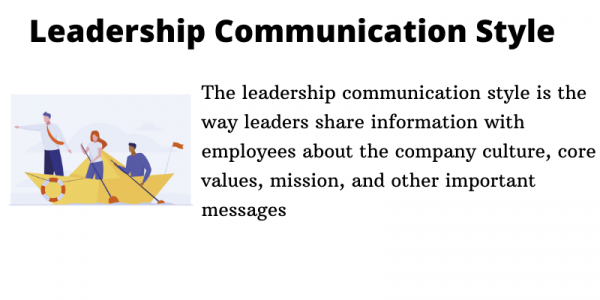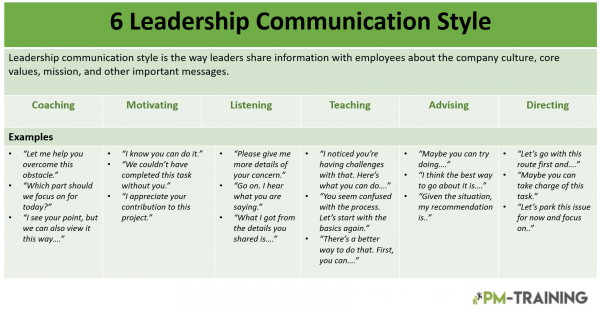As a leader, you should consider your communication skills as your bread and butter. If you can’t communicate effectively, you will have difficulty convincing people to follow your lead. Fortunately, communication is a skill that you can learn and improve through practice. By understanding the different communication styles, you will be better equipped to deliver your message in a way that resonates with your audience.
In this blog post, we will share the different leadership communication styles and when to use them. We’ll also share tips on improving your communication skills to be the best leader you can be.
What is Leadership Communication Style?
The leadership communication style is the way leaders share information with employees about the company culture, core values, mission, and other important messages.
Leaders can steer their company through any size or type of change by effectively communicating. The leadership communication style involves conveying a common goal and inspiring others to buy into it. It explains the company’s core principles and demonstrates how the firm keeps its promise.

Importance of Leadership Communication Style
Improves engagement

Leadership communication helps create a positive and productive work environment. When team members feel they are being heard and their opinions are valued, they are more likely to be engaged in their work.
Employees who are engaged will work harder, stay with the company longer, and improve customer service. All of those lead to improved business results. In turn, this engagement leads to higher levels of productivity and creativity.
Keeps everyone aligned with the common goal
To be an effective leader, you must be able to align your employees with the organization’s strategic goals. Only then can you ensure that everyone is working towards the same organizational objectives.
The best way to do this is to articulate the organization’s vision and values clearly, and then make sure everyone understands their role in achieving those goals. By taking the time to connect with employees, you can create a shared sense of purpose that will inspire them to do their best work.
Builds trust and transparency
Communication is the foundation of any effective leader-follower relationship. It builds trust by creating transparency and mutual understanding and gives leaders the ability to influence and inspire their followers.
Good communication allows leaders to give clear instructions and expectations, allowing employees to voice their concerns and offer suggestions. A leader should be able to handle external communications.
Creates a collaborative culture in the workplace

Communicating effectively allows leaders to create an environment where team members feel comfortable working together toward a common goal. Effective leadership communication can help to build respect between team members, fostering a sense of teamwork and cooperation.
Valuing input from each team member creates an environment where old ideas can improve or new ideas can flourish.
Different 6 Leadership Communication Styles
Coaching
With this type of leadership communication, the leader puts their time and energy into developing team members. Not only does this improve the individual’s performance, but it also boosts the team’s and organization’s as a whole.

Coaching leadership has become increasingly popular in workplaces because it breeds positive growth skills, brushes up on company objectives, and encourages confidence within a company’s culture.
Leaders with the communication approach not only provide their staff with the groundwork for success and alternative routes to achieving it but also allow them to determine which path is best for them.
When to use it?
- During low-stress scenarios and doesn’t need to make quick decisions
- There’s ample time to achieve the goal
- When employees have a hard time getting started with a task
- When the employees need guidance and advice on a project
Examples:
- “Let me help you overcome this obstacle.”
- “Which part should we focus on for today?”
- “I see your point, but we can also view it this way….”
Motivating
This leadership communication style is characterized by leaders who use purposeful, enthusiastic dictation to get people to act. This leadership style always seems to know exactly what to say to encourage their team and give them the push they need to get started.

This style is the most successful in moments of urgency when your team has to work together quickly to finish a job. Encouraging your team is a great way to communicate with them because it will motivate them to perform at their best.
Although not everyone can be a cheerleader, those who take on the motivator role often form personal connections with employees.
When to use it?
- The group needs encouragement to complete a task
- An employee is struggling with his or her new role
- The team needs a morale boost
Examples:
- “I know you can do it.”
- “We couldn’t have completed this task without you.”
- “I appreciate your contribution to this project.”
Listening
Leaders who seek feedback, suggestions, and ideas from their employees are most likely listening communicators. This style of communication is special because employee expression is the top priority. This can be in the form of osmotic communication.

Listening leaders are very good at understanding what employees think or hearing what they’re not saying to identify any unmentioned challenges and frustrations. Leaders with this communication style must learn when to listen and when to speak and take charge. You need to be able to show employees that you’re decisive while still utilizing their feedback effectively.
When to use it?
- Employees are explaining a problem
- There’s a workplace conflict that needs to be solved
- During one-on-one meetings
- An employee is giving feedback
- When doing employee evaluation
Examples:
- “Please give me more details of your concern.”
- “Go on. I hear what you are saying.”
- “What I got from the details you shared is….”
Teaching
The teaching communication style is embodied by those always seeking ways to share their expert knowledge and improve the team. This leadership communication style focuses on employee development and equips team members with the relevant skills for their roles.

The best teaching communicators focus on three key elements: explaining how something works, needed procedures, and why the topic. Failure to explain the why behind the tasks lead to confusion, suspicion, and a sense of micromanagement.
When to use it?
- When employees are having challenges with mastering skills or performing tasks.
- Some employees need to learn specific skills necessary to excel in their roles.
Examples:
- “I noticed you’re having challenges with that. Here’s what you can do….”
- “You seem confused with the process. Let’s start with the basics again.”
- “There’s a better way to do that. First, you can….”
Advising
People often come to these leaders for help whenever they have a question, are struggling with something, or need more information on a process. It is because they trust that these individuals can provide answers and solve any problems the team is facing.

The major disadvantage of this style is that there’s a tendency for the employees to become too dependent. Leaders with an advising communication style should avoid allowing their staff to become too reliant on them.
Employees must also have the independence to be productive workers and acquire crucial critical thinking and problem-solving abilities.
When to use it?
- The situation requires clarity
- Need to solve a conflict between employees
- Answering questions from the team
- Giving alternative perspective
Examples:
- “Maybe you can try doing….”
- “I think the best way to go about it is….”
- “Given the situation, my recommendation is..”
Directing
The directing communication style helps managers be clear and concise when communicating expectations and processes to employees, improving productivity.

A directing leader lays out significant steps the team must take to finish a project. Directing communication style is useful in fields that don’t require people to develop innovative ideas.
As a leader, you should not mix up directing with dictating. Try telling the actions needed to succeed rather than ordering people around. Also, don’t overlook employee queries, and listen to their feedback.
When to use it?
- “Let’s go with this route first and….”
- “Maybe you can take charge of this task.”
- “Let’s park this issue for now and focus on..”
Tips to Improve Your Leadership Communication Style
- Be clear and concise in your communications. Do not use jargon or technical terms that your team might find hard to understand.
- Be conscious of the tone of your voice and your body language. Your nonverbal cues can convey just as much information as your words do.
- Listen actively and carefully before responding. It will show your team that you value their input and consider all available options before deciding.
- Practice empathy by trying to see things from your team’s perspective. It will help you better understand their needs and how best to communicate with them.
Leadership communication style is a vital tool every leader should master to convey messages and achieve objectives within their team effectively. Communicating effectively will help you foster relationships, inspire employees, and build a productive workplace.
The most important thing to remember is that there is no one-size-fits-all approach to leadership communication. Your style will depend on the situation and your team’s needs.
With practice, you’ll be able to switch between styles seamlessly and become an effective leader in no time.
